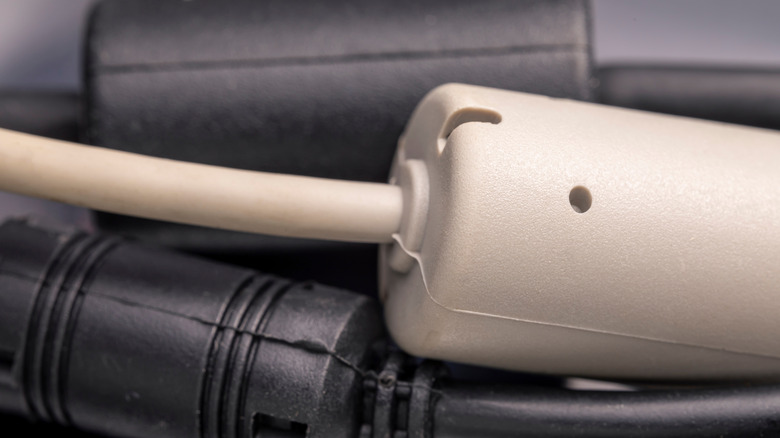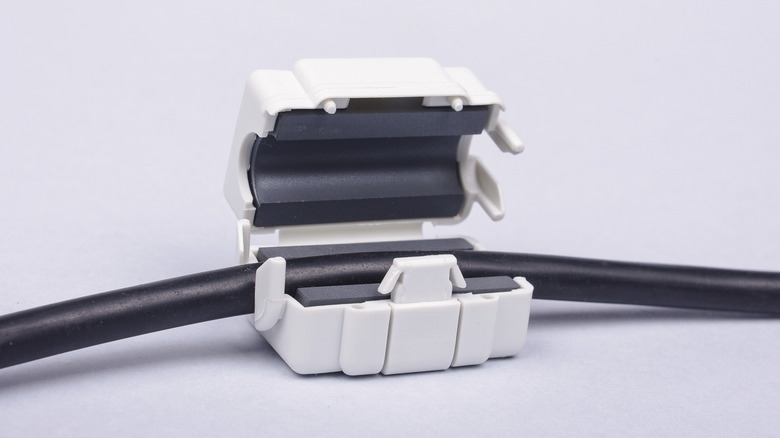The Mysterious Black Cylinder On Your Cables Isn't Just For Decoration
That little plastic cylinder at the end of a cable isn't there just to get in your way, it actually serves a purpose. Though we live in an age when cybercriminals can install microcomputers in iPhone cables, there's nothing inherently nefarious about a ferrite bead. In fact, they're actually super useful.
You can call that plastic cylinder a ferrite bead, a ferrite choke, EMI filter, ferrite core, or ferrite block. Whatever name you choose, the cylinder still serves the same purpose, which is to block radio-frequency interference (RFI) and electromagnetic interference (EMI) within cables and electronics. Ferrite is composed of iron oxide, and its magnetic ceramic material ensures there's no interfering noise coming from or leaving devices. While a ferrite bead can be built directly into smaller cables, larger cables are likely to have that familiar cylinder.
Whether it's the power cable to your monitor, or an old USB cable, that little plastic doohickey is helping you avoid disaster. Without enrolling you in an entry-level engineering course, let's take a simplistic approach to this helpful material.
It isn't magic, it's science
You may not notice it, but the electronics in your house can produce an awful amount of noise. Your ears are unlikely to pick it up, but your electronics certainly can, which is why ferrite plays an excellent role in dissipating this noise. Without a ferrite core, EMI and RFI signals are likely to interfere with your electronics. This interference can be small, like an LED monitor flickering, or it can be something larger, such as an old microwave lacking ferrite interfering with a new computer when next to it.
In these situations, ferrite is good for managing frequencies: highs will dissipate into heat, whereas the lower frequencies pass between devices.
Not every accessory needs a ferrite core. Take a computer and its case, as an example. While certain components inside the machine, like the motherboard, may produce a large amount of frequencies, the computer's case helps block them. However, a case may not have any or enough of the materials to do this on its own, which is where ferrite comes into play. So even though certain ferrite beads may prevent you from taking advantage of the accessories designed to hide the power cables in your home, you can at least be assured that the little ceramic magnets are doing their part to help.
Can ferrite beads cause issues?
While ferrite beads are capable of causing problems, the vast majority of issues will be at a manufacturer or engineering level, not a consumer level. Since ferrite is a low-pass filter, engineers need to understand their function to ensure the correct filtering levels.
For example, ferrite can become saturated if it takes on a high enough current, allowing higher frequencies to pass and create issues for the component or device. Essentially, engineers need to ensure they are eliminating the right frequencies while preserving the necessary ones.
You don't really need to worry about the drawbacks of ferrite when connecting your power cable to your printer, but a scientist engineering a cable with twice the power of a Thunderbolt 4 might. If you don't plan on engineering your own cables or components, knowing the role this material plays within your devices can help maintain longevity. Or, at the very least, it stops your devices from having weird conversations with each other.


